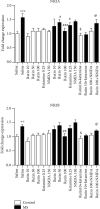Rutin via Increase in the CA3 Diameter of the Hippocampus Exerted Antidepressant-Like Effect in Mouse Model of Maternal Separation Stress: Possible Involvement of NMDA Receptors
- PMID: 32587637
- PMCID: PMC7296444
- DOI: 10.1155/2020/4813616
Rutin via Increase in the CA3 Diameter of the Hippocampus Exerted Antidepressant-Like Effect in Mouse Model of Maternal Separation Stress: Possible Involvement of NMDA Receptors
Abstract
Methods: Mouse neonates were exposed to MS paradigm 3 hours daily from postnatal days (PND) 2 to 14. The control and MS mice were divided separately into 16 groups (n = 8) (8 groups for each set) including mice that received normal saline, mice that received rutin at doses of 10, 50, and 100 mg/kg, mice that received NMDA at a dose of 150 mg/kg, mice that received ketamine (NMDA antagonist) at a dose of 0.25 mg/kg, mice that received NMDA antagonist plus a subeffective dose of rutin, and mice that received NMDA plus an effective dose of rutin. Forced swimming test (FST) was performed. Afterwards, the hippocampus was evaluated in cases of histopathological changes as well as expression of NR2A and NR2B genes.
Results: Rutin significantly reduced immobility time in the FST. The expression of NR2A and NR2B subunits of NMDA receptor in MS mice was significantly higher than that in the control group. Rutin significantly decreased the expression of NR2B and NR2A subunits in the hippocampus. The CA3 diameter and percentage of dark neurons in the hippocampus of MS mice significantly decreased and increased, respectively, which partially reversed following rutin administration.
Conclusion: Rutin, partially, through a neuroprotective effect on the hippocampus exerted antidepressant-like effect. We concluded that NMDA receptors, at least in part, mediated the beneficial effect of rutin.
Copyright © 2020 Maryam Anjomshoa et al.
Conflict of interest statement
The authors have no conflicts of interest to declare regarding the study described in this article and preparation of the article.
Figures






Similar articles
-
Diosgenin via NMDA Receptor Exerted Anxiolytic-like Effect on Maternally Separated Mice.Curr Pharm Des. 2021;27(3):440-445. doi: 10.2174/1381612826666200717083211. Curr Pharm Des. 2021. PMID: 32679011
-
Possible Involvement of N-methyl-D-aspartate Receptor (NMDA-R) in the Antidepressant- like Effect of Trigonelline in Male Mice.Curr Pharm Des. 2020;26(39):5067-5071. doi: 10.2174/1381612826666200610181259. Curr Pharm Des. 2020. PMID: 32520677
-
Instant and Lasting Down-Regulation of NR1 Expression in the Hippocampus is Associated Temporally with Antidepressant Activity After Acute Yueju.Cell Mol Neurobiol. 2016 Oct;36(7):1189-96. doi: 10.1007/s10571-015-0316-1. Epub 2016 Jan 29. Cell Mol Neurobiol. 2016. PMID: 26825573 Free PMC article.
-
Implication of NMDA-NO pathway in the antidepressant-like effect of ellagic acid in male mice.Neuropeptides. 2019 Aug;76:101928. doi: 10.1016/j.npep.2019.04.003. Epub 2019 Apr 26. Neuropeptides. 2019. PMID: 31078318
-
Involvement of N-methyl-d-aspartate receptors in the antidepressant-like effect of 5-hydroxytryptamine 3 antagonists in mouse forced swimming test and tail suspension test.Pharmacol Biochem Behav. 2016 Feb;141:1-9. doi: 10.1016/j.pbb.2015.11.009. Epub 2015 Nov 19. Pharmacol Biochem Behav. 2016. PMID: 26604075
Cited by
-
Antidepressant Potential of Quercetin and its Glycoside Derivatives: A Comprehensive Review and Update.Front Pharmacol. 2022 Apr 8;13:865376. doi: 10.3389/fphar.2022.865376. eCollection 2022. Front Pharmacol. 2022. PMID: 35462940 Free PMC article. Review.
-
Neuroprotective effects of rutin against cuprizone-induced multiple sclerosis in mice.Inflammopharmacology. 2024 Apr;32(2):1295-1315. doi: 10.1007/s10787-024-01442-x. Epub 2024 Mar 21. Inflammopharmacology. 2024. PMID: 38512652 Free PMC article.
-
Phytochemicals That Act on Synaptic Plasticity as Potential Prophylaxis against Stress-Induced Depressive Disorder.Biomol Ther (Seoul). 2023 Mar 1;31(2):148-160. doi: 10.4062/biomolther.2022.116. Epub 2023 Jan 25. Biomol Ther (Seoul). 2023. PMID: 36694423 Free PMC article. Review.
-
Possible role of NO/NMDA pathway in the autistic-like behaviors induced by maternal separation stress in mice.PLoS One. 2023 Oct 10;18(10):e0292631. doi: 10.1371/journal.pone.0292631. eCollection 2023. PLoS One. 2023. PMID: 37815997 Free PMC article.
-
Prolonged Maternal Separation Induces the Depression-Like Behavior Susceptibility to Chronic Unpredictable Mild Stress Exposure in Mice.Biomed Res Int. 2021 Jul 29;2021:6681397. doi: 10.1155/2021/6681397. eCollection 2021. Biomed Res Int. 2021. PMID: 34368355 Free PMC article.
References
-
- Jazayeri S., Keshavarz S. A., Tehrani-Doost M., et al. Effects of eicosapentaenoic acid and fluoxetine on plasma cortisol, serum interleukin-1beta and interleukin-6 concentrations in patients with major depressive disorder. Psychiatry Research. 2010;178(1):112–115. doi: 10.1016/j.psychres.2009.04.013. - DOI - PubMed
-
- Emamghoreishi M., Talebianpour M. Antidepressant effect of Melissa officinalis in the forced swimming test. DARU Journal of Pharmaceutical Sciences. 2015;17(1):42–47.
MeSH terms
Substances
LinkOut - more resources
Full Text Sources
Miscellaneous

